Article MT095 - from Musical Traditions No 12, Summer 1994
... two customs observed
I: Mystery Plays in the West Indies
The following text and illustrations are reprinted from Wide World Magazine, VII, 38 (May, 1901). The material is of considerable historical interest because of the detail it provides on a particularly interesting and relatively little-known seasonal custom. The author, Dorothy Harding, had apparently lived in the Caribbean for some years. The editors feel that its value as source material justifies reproduction of what would otherwise be unacceptable in terms of its racist perspective and tone. Thanks to Chris Beaumont for supplying a copy of the original.
Additional background material on Mongoose Plays can be found in John Cowley, L'Année Passée: Selected Repertoire in English-Speaking West Indian Music, 1900-1960, Keskidee, III (1993).
The West Indian negro has two national amusements, and two only, of which he can truthfully say, like the Knight in 'Alice in Wonderland', that they are 'an invention of his own'.
The first of these is the mysterious Jumbi dance, which is strictly pagan in its origin, and may be traced back to those primeval days when the religion, the gin, and the cheap cotton goods of the white man were alike unknown to the African savage, and when his idea of the whole duty of man consisted in clubbing his enemy on the head first, and eating him afterwards. 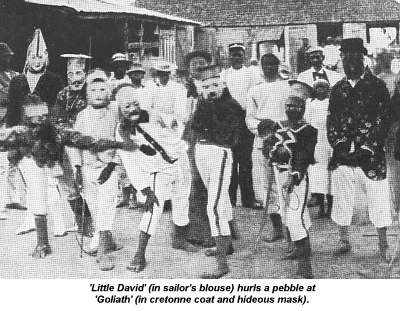 Two centuries of close association with Christianity and civilisation have only served to dilute, not to eradicate, his original belief in Obeah and Fetish; and it is doubtful if the Jumbi dance of today - which is in reality a sort of secondhand spiritualist seance - differs largely from the heathenish rite performed hundreds of years ago by his ancestors in the wilds of Africa.
Two centuries of close association with Christianity and civilisation have only served to dilute, not to eradicate, his original belief in Obeah and Fetish; and it is doubtful if the Jumbi dance of today - which is in reality a sort of secondhand spiritualist seance - differs largely from the heathenish rite performed hundreds of years ago by his ancestors in the wilds of Africa.
Their one other original festivity is the exact antithesis of this semi-barbaric function, being plainly traceable to a Christian source, and is, in fact, the species of Mystery Play which forms such a striking feature of the Christmas masquerades of these negroes.
That they should have hit upon a masquerade as the best means of celebrating the great Christian festival is in no way remarkable, for it enables them to gratify at one and the same time their passion for music and their childish love of 'dressing up' and their passion for music and dancing. But that a race so notably lacking in the power of initiation should have evolved the idea of acting the Bible stories, very much as they were acted by the monks of old for the instruction of an ignorant laiety, is, to say the least of it, somewhat surprising.
It may be safely said that the negro is never too tired to dance and never too downhearted to sing; but it is only at Christmas that he indulges in these amusements for the benefit of the buccra.
Regularly every year the black portion of the community gets permission from the commissioner, administrator, or whatever polysyllabic dignitary happens to be at the head of affairs in each separate island, to let themselves loose on society in approved fashion; and they forthwith throw themselves body and soul into the enjoyment of the hour.
For weeks beforehand they are busy rehearsing their parts and preparing stage properties, such as masks, head-dresses, costumes, stilts etc., but it is not until the last stroke of midnight on Christmas Eve that the fun begins. That is to say, the fun from their point of view - not from that of the unfortunate audience.
The probability is that you are just in the middle of your first sweet slumber when you are awakened by what you first imagine to be the sound of 'the last trump's awful din'. 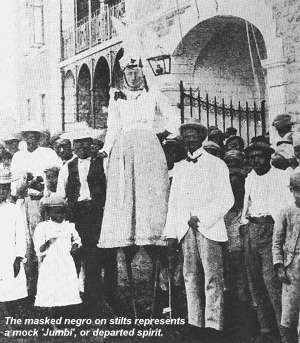 Try to fancy the effect produced by a simultaneous blast, each in a different key, from a few dozen conch shells, concertinas, tin cans, fiddles, penny whistles, tambourines, and drums, and if your imagination is strong enough to picture that much, you will be able to gain a fairly good idea of what the hideous uproar is like.
Try to fancy the effect produced by a simultaneous blast, each in a different key, from a few dozen conch shells, concertinas, tin cans, fiddles, penny whistles, tambourines, and drums, and if your imagination is strong enough to picture that much, you will be able to gain a fairly good idea of what the hideous uproar is like.
All night long this pandemonium continues, gathering force every hour, and the weary watcher can do nothing but tie a wet towel round his head and, like the shipwrecked apostles, "wish for day".
These revels last for a fortnight or more, and not only is the non-combatant expected to bear them with an outward semblance of enjoyment, but, to add insult to injury, backshish is continually demanded of him by the performers, who make it their guiding principle to get as drunk as their resources will permit - which, by the way, with native rum at tenpence a bottle, is very drunk indeed.
The mummers are divided into two classes - those who act set-pieces, such as David and Goliath and Mongoose plays depicted in the first and second photographs, and those who merely dance and kyact for the entertainment of the onlooker. The third picture represents a mock jumbi, that is to say, an imitation departed spirit; this role being taken by a man in female attire, and having his face concealed by a mask. This person skirmishes around on stilts, and finds himself admirably suited to his part which consists in making himself a general nuisance to all parties.
In the first illustration the photographer has caught the youthful champion of the Israelites, dressed in a sailor's blouse, white cotton trousers, and hat of unknown design, in the act of hurling the deadly pebble at the forehead of the Philistine giant, who, clad in a gaily flowered cretonne coat, crush hat, and hideous mask, is waiting to receive his death blow with calm philosophy.
On the extreme left may be seen the Israelitish king, with arms outstretched, delivering an impassioned address to his warriors. The historical accuracy of his costume is, I am bound to say, somewhat impaired by the fact that his breastplate, which has slipped down rather low, is made out of the cover of a Keen' s blue box .
To enable the reader to understand the second illustration it is necessary to explain that each island localises its own performances much in the same way that a London pantomime has to be adapted to suit the needs of a provincial town. The Mongoose Play, which is peculiar to St Kitts, furnishes an excellent instance of this fact.
Some years ago the island was infested with snakes and rats, and the mongoose was imported to exterminate them, which it did: 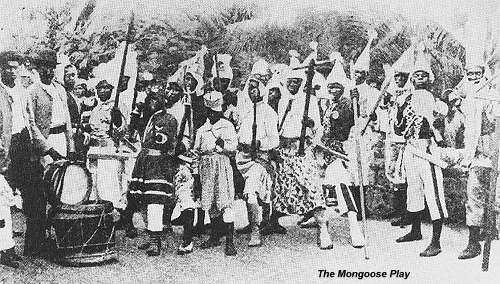 but not satisfied with leaving well alone it next turned its attention to the poultry - a contingency for which the Kitifonians were by no means prepared.
but not satisfied with leaving well alone it next turned its attention to the poultry - a contingency for which the Kitifonians were by no means prepared.
They have now come to the sorrowful conclusion that the remedy is considerably worse than the disease, and hence the play, which is evidently undertaken with the object of waging deadly war against these destructive little animals.
In looking at this group of fiercely scowling negroes, with their savage get-up and their mimic weapons, it does not need a very long stretch of the imagination to fancy that they are back in their native Africa, with every trace of civilisation effaced, and giving themselves up heart and soul to the enjoyment of some wild death-dance or cannibal feast. The masqueraders are strolling players pure and simple, but, besides obstructing all the principal thoroughfares with their antics, they delight in giving special private performances in the gardens of the white people, and to a stranger the spectacle they present is both picturesque and interesting.
The spirited music, the bright colours of the dresses, the glitter of tinsel and the spangles in the brilliant sunshine, and the lithe, swiftly-darting figures of the dancers, not dancers in the languid, slip-shod fashion so often seen in English ball-rooms, but with a passionate, sensual delight in every graceful bend and twirl - all this, set off against a background of rustling palms and gorgeous tropical shrubs, goes to make up a picture not easily to be surpassed for quaintness or vividness of colouring.
Dorothy Harding
II: Christmas Sports observed - Christmas, 1991
This is a personal account of our observations of traditional events on the islands of St Kitts and Nevis in the West Indies at Christmas, 1991. There are various theories on the origin of the Christmas Sports which take place on these islands, former British dependencies that gained independence in 1983. However, ours is an account of what we saw, rather than an exploration of the reasons for their existence.
We first heard about the Masqueraders from a close friend who lives on St Maarten, Netherlands Antilles, an island 100 km north of St Kitts. He had seen them perform at Christmas 1987 and sent a copy of the photographs he had taken, along with a small book called Christmas Sports in St Kitts-Nevis 1, which he bought in Basseterre, the capital of St Kitts. 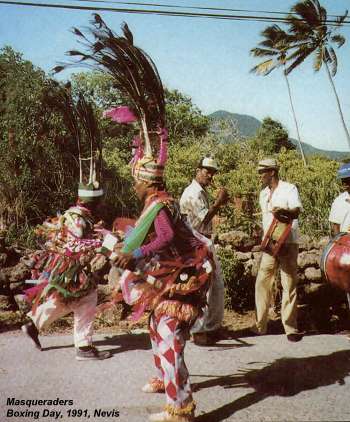 This gives information about various Christmas customs, including 'Moko Jumbies', 'Cowboys and Indians', 'Masqueraders' and 'Mummies'. When our friend invited us to visit him we decided we would have to go at Christmas in the hope of being able to see some of the sports ourselves. This, then, is a chronological account of the events we were lucky enough to see during our stay on the islands.
This gives information about various Christmas customs, including 'Moko Jumbies', 'Cowboys and Indians', 'Masqueraders' and 'Mummies'. When our friend invited us to visit him we decided we would have to go at Christmas in the hope of being able to see some of the sports ourselves. This, then, is a chronological account of the events we were lucky enough to see during our stay on the islands.
Christmas Eve - Basseterre, St Kits
The main square in Basseterre was the centre for the evening festivities starting the carnival period, which lasts until 2 January. The evening events began with speeches by the Prime Minister. The crowd packing the square consisted mainly of local people and there were very few obvious tourists. There was a stage on one side of the square with massive banks of speakers for the bands which were to come on later. The crowd were kept in order by the police force, but the proceedings were very good natured.
When the Prime Minister had finished his speech a children's steel band played, after which the Mummies came on. This was something we had not expected to see, as all the references to the Mummies that we had come across had been for Boxing Day onwards. This unfortunately was to be the only time that we saw a team of Mummies .
Due to the size of the crowd, the Mummies attempted to recite their words through one hand-held microphone that was passed from performer to performer. This was far from satisfactory since, despite the huge array of speakers, it was very difficult to actually hear the words and it proved impossible to record them. However the following is as close an account as we can manage of the play itself.
The performance lasted approximately 25 minutes. It started with six players (four men, two women) and two drummers coming onto the stage dancing, firstly in a line with the other five copying the captain's steps. The performers had hats numbered between one and eight (some must have been missing) and the captain's hat said 'Me run things'. One of the others carried a whip.
The captain went to the front and called out each dancer in turn, the dancers then formed up into two lines of three, and corner crossing movements were performed - these were often very suggestive as the dancers passed around each other. After some more apparently less formalised dancing the play started. Most of the parts were taken by just three performers, although one of the women did have one line to say.
The play opened with a Father Christmas speech - something about him being very old, and doing something for 333 years, and 'room, room brave boys'. Saint George came in with the line 'In comes I, Saint George, who from old England sprung'. Then the character we presume to be the Black Prince fought with Saint George. The fight was performed in a stylised manner with long sticks and in an energetic fashion. The Black Prince did not lie down dead and no doctor appeared. (A lady in the crowd in front of where we were standing was obviously expecting one - she said 'a dollar, a dollar' before the next speech). Other recognisable lines after the first fight were:
'Alas, my chiefest son is slain.'
'I am the King of [unclear], as plainly doth appear, I've come to seek my son.'
'What hast thou done, thou hast ruined me?'
'He offered me a challenge.'
'Now the prince of paradise (?) is dead.'
The second fight followed with:
'Yes, my liege, I will obey,'
'At the sound of the trumpet and the beat of the drum.'
At one point in the play one of the Mummies played a sort of flute along with the drummers. The play finished with all the performers coming to the front of the stage and bowing.
The lady in the audience who had said 'a dollar, a dollar' told us that there is only one lot of Mummies on St Kitts, but we were not sure if she meant that they would perform on the lst/2nd January or until lst/2nd January.
The next performance was by a team of Masqueraders. There were about twelve performers who did a dance routine similar to that of the Mummies, but took longer since there were more of them. At the beginning they were carrying what appeared to be small wooden tomahawks, which were laid down. The leader then called the others out one at a time to perform steps that all the others would try and copy. They did the corners figure like the Mummies and the most suggestive movements were done by the youngest dancers, much to the delight of the crowd!
As with the Mummies one performer carried a whip while four performers wore masks - faces made out of card with tinsel round the edges. There were two very young performers, and the oldest were probably in their mid-twenties. They used the same drummers and whistle players as the Mummies. At one point in the dance they formed into a circle of couples, doing side-steps around the ring and changing partners. Later on a young child from the audience was lifted on to the stage and surrounded by the dancers, who joined hands and circled round and closed in. This upset the child! The different movements of the dance were interspersed with pauses during which the music continued while the dancers took a rest. Again they finished by bowing to the audience.
The Masqueraders were followed by the Moko-Jumbies, five men on stilts of varying heights who danced in front of the stage. The movements were very free-form apart from when two of them waltzed together. At one point one went under the legs of another. They appeared to be very popular with the audience and played to them - a person taking pictures of them laid on his back and three of the performers walked over him. They used the same musicians as the Masqueraders and Mummies.
Christmas Day - Charlestown, Nevis
In the early afternoon a team of Masqueraders assembled in the square in the centre of Charlestown. However, they disappeared in a pickup truck and we were not able to follow them. At least one team had performed at the Golden Rock Hotel (an ex-plantation estate) at 10.30.
In the evening there should have been a display at the Cultural Complex, an open air arena in Charlestown. Billed were the Cotton Ground Masqueraders, Rawlins Masqueraders, Norman Libert Masqueraders, Clowns, Cowboys and Indians, singers, groups from schools, a string band and Ashati Dancers. Unfortunately, as the performers were assembling the town police station caught fire and all electricity was cut off, so the entertainment was cancelled. The event was promoted by the Community Cultural Group and appeared to be for the residents of the island rather than tourists.
Boxing Day - Gingerland / Bucks Hill, Nevis
We had great difficulty locating performances of any kind but eventually came across both Cowboys and Indians and Masqueraders performing in different areas of the same village. Both teams appeared to be going from house to house and bar to bar.
The Masqueraders were led by Dan Libert (known as Black Dan), who told us that he has been performing since 1939. (He may know of the Mummies, although he said there are none on the island now). 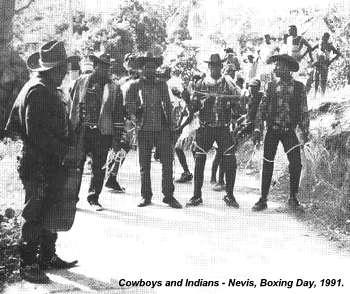 There were only four Masqueraders, accompanied by two drummers and one fife player, but they were very keen to dance for us (for a consideration!). They were all fairly drunk, so the performance left a lot to be desired, but it was definitely the real thing - not for the tourists.
There were only four Masqueraders, accompanied by two drummers and one fife player, but they were very keen to dance for us (for a consideration!). They were all fairly drunk, so the performance left a lot to be desired, but it was definitely the real thing - not for the tourists.
There were frequent arguments over the speed of the music between dancers and musicians, dancers and audience (not us!) and dancers and dancers. The only recognisable figures were right hand turn across the corners, other corner movements and lots of shaking movements. Towards the end limbo type movements were also used. They finished in a long line facing us going backwards and forwards, with one of the performers beckoning for money. Their ages ranged between about twenty and seventy. Dan Libert said that he was the one to ask for any information on the customs of the island. However, due to the inebriated state of the team it did not seem the best time!
The Cowboys and Indians approached us and asked if they could perform for us, haggling about the price before they did so . There were five Indians and five Cowboys, and they were accompanied by a string band playing guitars, small guitars, whistles and drums. The performance started with the Indians dancing in a serpentine fashion to the music. The leader then blew his whistle, which was the signal for the Cowboys to begin their play. This was something about a rabbit, but as the words were only mumbled it was hard to hear what was actually being said. The leader blew his whistle at the end of the play and the Indians danced again. The Cowboys then walked about twirling their lassos and the leader came for the money.
Despite driving around the island twice, we encountered no further performers of any type. We spoke to the owner of a small bar in Pot Works settlement who said that Masqueraders used to come there, but no more. However, he thought that there were still Mummies on the island. We discovered that the String Bands were very popular at that time of year. The Honey Bees were due to play at the Golden Rock Hotel on the Saturdays after Christmas and New Year and another had played in Pot Works one evening before Christmas.
All day in the centre of Charlestown (we think starting at 4 a.m.) loud music blared out from speakers on the back of a lorry, which occasionally moved a short distance up and down the street with a few people following. Dancing to music in this fashion is known as a 'Jump'.
27 December, Nevis
One masquerader was seen outside a bar in the Chicken Stone / Beach Road area. He had not been in the group that we had seen on Boxing Day. A few hundred yards further on the Cowboys and Indians were performing outside another bar.
28 December - Basseterre, St Kitts
At 11 a.m. a team of Masqueraders performed at the Berkeley Monument, The Circus, right in the centre of Basseterre. This was a different team to the one that had performed on Christmas Eve. 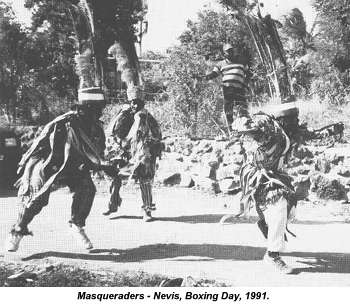 The dance followed a similar format to that seen previously except that at one point the people watching threw money on the ground. The dance stopped and the money was collected into a pile in the middle and a circle of water from the fountain in the monument was poured around it.
The dance followed a similar format to that seen previously except that at one point the people watching threw money on the ground. The dance stopped and the money was collected into a pile in the middle and a circle of water from the fountain in the monument was poured around it.
The dance resumed with circling movements around the pile. Suddenly, dancers from various positions in the set darted forward and grabbed handfuls of money from the pile. The audience here was a mixture of locals and tourists.
Until this performance we had found it difficult to recognise the melody in any of the music accompanying the dancing; however, the flute player this time definitely broke into a very unusual version of Jingle Bells!
At 3 p.m., yet another team of Masqueraders performed to a small audience outside a house in College Street, a residential area on the edge of the town. The group then retired to a bar.
The following day was a Sunday and we were told that the Masqueraders did not perform on Sundays. Unfortunately we then had to leave the islands and head back to St Maarten where we spent the New Year.
Costumes:
1. The Mummies
All wore a crown numbered between one and eight, some with mirrors on the front, and painted in rings of red, yellow and green. They wore trousers and a jacket made of either patchwork or brightly coloured material. No two were exactly alike, although they were basically red except for one character who was wearing blue. Over the jacket were pinned long ribbons, possibly on a separate tabard. The sticks used for the fights were about 4 ft. long and painted with red, yellow and green stripes. The musicians were in ordinary clothes.
2. Masqueraders, Christmas Eve
All wore red crowns topped with peacock feathers; again, some had mirrors. Jackets and trousers were red with large black polka-dots. Ribbons and mirrors were attached to a tabard worn over the top and at least one costume had bells attached. Footwear was ordinary trainers. The tomahawks were painted red with white tips.
3. The Moko Jumbies
One was dressed in a grass skirt with a garland around his neck and he had long black trousers covering his feet and the top of his stilts. The others had much longer trousers (made from bright patterned material) which went almost down to the ground. The tops were either patterned material or a T-shirt. One had matching trousers and top and also wore a tall clown's hat.
4. Masqueraders, Boxing Day
All wore green crowns with a white stripe around them, topped by peacock feathers with some pink feathers amongst them. The dress appeared to be long tabards down to the knees covered in multicoloured ribbons and mirrors, worn over normal clothes. The bottom of some of the trousers had a ruff of small ribbons around the hem. The musicians were not in costume.
5. Cowboys and Indians
The Cowboys wore blue denim jeans, most with white piping down the sides, neckerchiefs and cowboy hats. Each had a waistcoat which bore the name of a cowboy character on the back; e.g. Slim Wilson and Billy the Kid. All except the leader carried a lasso and they had cap guns but these were not used. The Indians wore feather head-dresses, shorts and T-shirts which had slits cut in them. They all carried tomahawks and some carried whips which they cracked during the dancing.
6. Masqueraders - centre of Basseterre
All wore crowns painted red and white, and peacock feathers. They had multi-coloured jackets and trousers and tabards covered in ribbons and mirrors. Their tomahawks were red, edged in white around the blade, and both hats and tomahawks were numbered.
7. Masqueraders - back streets of Basseterre
They were dressed mainly in red with various patterns and red crowns with peacock feathers. They had ribbons and mirrors on a tabard and a little skirt around the waist.
We discovered that, with the exception of Black Dan, it was very difficult to get to talk to any of the performers. There is an assumption that if you are white you are an American and therefore a rich tourist, and it was difficult to overcome this. We suspect that even Black Dan did not think that we were seriously interested in the events taking place, although we showed him photographs of English Pace Eggers and North West Morris Dancers. However, we did not encounter any hostility, although our friend who had seen the Masqueraders previously in the north of St Kitts was told in no uncertain terms that he had watched enough. In this country when watching traditional events we like to try and keep to the back of the crowd and not be too obtrusive - this approach does not work so well when you are the only strangers in a small audience.
Note:
For anyone thinking of going to the islands to see the Christmas Sports we would recommend that transport is arranged before travelling. We were lucky enough to be able to hire a car on Nevis on Boxing Day, but it proved impossible to hire any vehicle on St Kitts at this time of the year. Many emigrants from St Kitts return for the festivities of which the Christmas Sports are but a small part, and we were told that car hire should be arranged by September.
Travel between St Kitts and Nevis is by a small passenger ferry operating once each way daily. Alternatively, there is a private launch travelling several times daily from Basseterre and the Four Seasons holiday resort on Nevis. It may be possible to arrange travel on this or other private yachts.
We would like to thank both John Pitts and Ron Shuttleworth who spent the days immediately before we travelled hunting out references to the Mummies and photocopying articles for us.
Peter Bearon and Alison Whitaker
1 Christmas Sports in St Kitts-Nevis, Our Neglected Cultural Tradition, by Frank L Mills, S B Jones-Hendrickson and lessons by Bertram Eugene. (Fredericksted, Virgin Islands, Eastern Caribbean Institute, 1984).
Article MT095
 Two centuries of close association with Christianity and civilisation have only served to dilute, not to eradicate, his original belief in Obeah and Fetish; and it is doubtful if the Jumbi dance of today - which is in reality a sort of secondhand spiritualist seance - differs largely from the heathenish rite performed hundreds of years ago by his ancestors in the wilds of Africa.
Two centuries of close association with Christianity and civilisation have only served to dilute, not to eradicate, his original belief in Obeah and Fetish; and it is doubtful if the Jumbi dance of today - which is in reality a sort of secondhand spiritualist seance - differs largely from the heathenish rite performed hundreds of years ago by his ancestors in the wilds of Africa.
 Try to fancy the effect produced by a simultaneous blast, each in a different key, from a few dozen conch shells, concertinas, tin cans, fiddles, penny whistles, tambourines, and drums, and if your imagination is strong enough to picture that much, you will be able to gain a fairly good idea of what the hideous uproar is like.
Try to fancy the effect produced by a simultaneous blast, each in a different key, from a few dozen conch shells, concertinas, tin cans, fiddles, penny whistles, tambourines, and drums, and if your imagination is strong enough to picture that much, you will be able to gain a fairly good idea of what the hideous uproar is like.
 but not satisfied with leaving well alone it next turned its attention to the poultry - a contingency for which the Kitifonians were by no means prepared.
but not satisfied with leaving well alone it next turned its attention to the poultry - a contingency for which the Kitifonians were by no means prepared.
 This gives information about various Christmas customs, including 'Moko Jumbies', 'Cowboys and Indians', 'Masqueraders' and 'Mummies'. When our friend invited us to visit him we decided we would have to go at Christmas in the hope of being able to see some of the sports ourselves. This, then, is a chronological account of the events we were lucky enough to see during our stay on the islands.
This gives information about various Christmas customs, including 'Moko Jumbies', 'Cowboys and Indians', 'Masqueraders' and 'Mummies'. When our friend invited us to visit him we decided we would have to go at Christmas in the hope of being able to see some of the sports ourselves. This, then, is a chronological account of the events we were lucky enough to see during our stay on the islands.
 There were only four Masqueraders, accompanied by two drummers and one fife player, but they were very keen to dance for us (for a consideration!). They were all fairly drunk, so the performance left a lot to be desired, but it was definitely the real thing - not for the tourists.
There were only four Masqueraders, accompanied by two drummers and one fife player, but they were very keen to dance for us (for a consideration!). They were all fairly drunk, so the performance left a lot to be desired, but it was definitely the real thing - not for the tourists.
 The dance followed a similar format to that seen previously except that at one point the people watching threw money on the ground. The dance stopped and the money was collected into a pile in the middle and a circle of water from the fountain in the monument was poured around it.
The dance followed a similar format to that seen previously except that at one point the people watching threw money on the ground. The dance stopped and the money was collected into a pile in the middle and a circle of water from the fountain in the monument was poured around it.